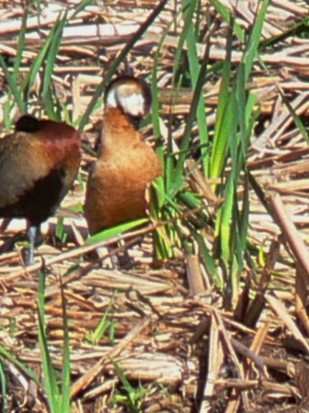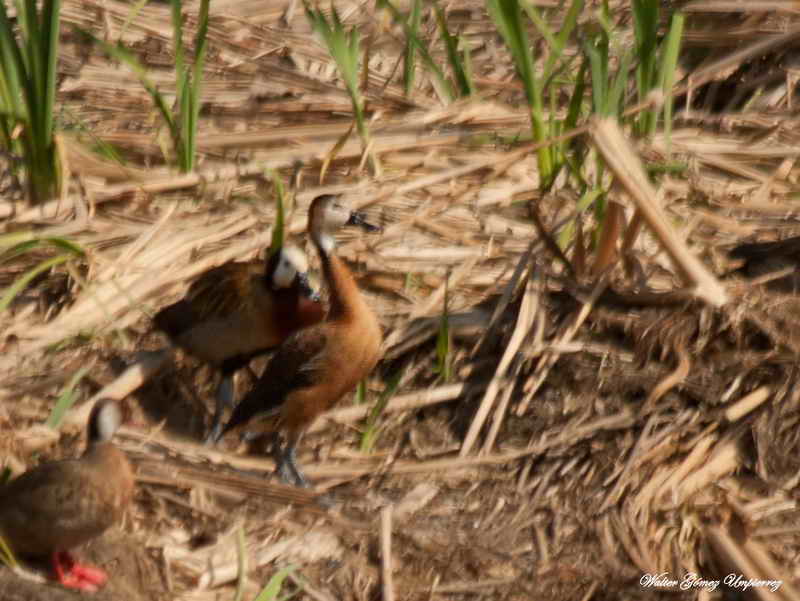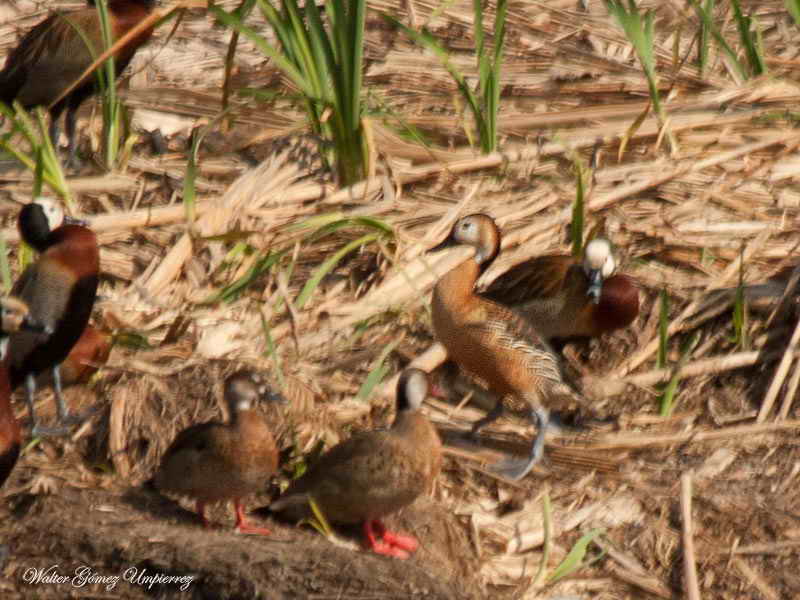A sighting of an atypical duck had been informed in the reserve and Sergio found it in one of his photos. Cinnamon underparts like a Fulvous Whistling-Duck with a white spot on the face. This could be a colour abnormality or a hybrid. The anatids interbreed readily and the white spot, which remembers that of the White-faced Whistling-Duck, leads us to think of a hybrid. Unluckily the position of the bird does not show other characteristics of the White-faced Whistling-Duck.
 © Sergio Cusano © Sergio Cusano |
This is the second case registered on this site. The previous one was reported by Germán Pugnali in 2006.
A hybrid is the result of the mixing of two species which are closely related. If genetics is not compatible, there will be no hybrid. If genetics is compatible there will be other instances such as behaviour, timing of reproduction, contact between species, etc. to overcome so that species can recognize and mate. These ethological, ecological, spatial, temporal, mechanical and genetic characteristics keep the species reproductively isolated from the rest and hinder the trespassing of this defence which keeps the cohesion of the species. In this sense the Fulvous and White-faced Whistling-Ducks belong to the same genus Dendrocygna. They are related, coexist in the same flock and their breeding season coincides. Conditions are favourable for a hybrid to be bred.
Hybrids are in general a dead end. They can not trascend their own existence since one of the principal problems hybridization causes is sterility. Nevertheless, if hybrids turn out fertile and manage to separate from its own parent species and reproductively isolate, a new species will emerge.
 © Walter Liriel Umpierrez © Walter Liriel Umpierrez © Walter Liriel Umpierrez © Walter Liriel Umpierrez |
But, what makes an individual mate with an inter-species individual? Hubbs proposed the desperation hypothesis. Hybridization is fostered by the lack of mate to form a pair. When the scarce species can not find an intra-species mate, it will turn to another species. This principle is applied to species living in sympatry, that is, cohabiting the same area, being one species very large and the other small in number. Big flocks of whistling-ducks arrived at Costanera. White-faced Whistling-Ducks greatly outnumbered Fulvous Whistling-Ducks. The 2008 drought drove them away but they came back when the ponds were refilled in 2013. The first to arrive were the White-faced Whistling-Ducks and later on Fulvous Whistling-Ducks did. Although the total number of individuals decreased considerably, the difference still stands. The principle is applicable to these Whistling-Ducks, but the movility of the flock makes any research study hard to be carried out. Unluckily this individual did not stay long to see how it interacted with the group to add more information. What we can deduce is that being this hybrid within a white-faced whistling-duck family, momm is a white-faced whistling-duck and dad a fulvous whistling duck.
Among atypical ducks we can also find the domestic ducks. They are atypical because they are not easily identified and do not appear in guides. Of these atypical ducks, the most frequently seen in the reserve are the domestic ducks. Though they are at loose, they are still called domestic since they were controlled by man and for some reason they are free now.
Since older times man has domesticated birds, ducks among them, for his own benefit. Two wild species have given rise to domestic ducks: Anas platyrhynchos from the Northen Hemisphere and Cairina moschata from South America. From Anas platyrhynchos originates the Pekin Duck, one of the most reknown breeds, which is all white and with orange bill and legs. The Southamerican version descending from Cairina moschata is known as Creole Duck.
The selective breeding of these ducks originated breeds always within the same species, so they are not hybrids. But when they are released and no longer controlled by man, these ducks may mate with individuals of any kind generating a wide range of variants.
Generally the atypical duck under study is a domestic duck. They are docile and are frequently seen in city parks. Nearness to the reserve facilitates their occurence. The Creole Duck is easily identified for its caruncles on the face. The orange and white colouring of the Pekin is a clear indicator, but we can find variants descending from the Mallard Duck Anas platyrhynchos that have nothing in common. Individuals of Creole Duck , Pekin Duck and Mallard Duck domestic variant with ancestral plumage showed up in Costanera.
Being with the parent species helps in the identification, even more if they have characteristics in common. But they may not resemble the parent species. In our case this duck was with other whistling-ducks and had at least one characteristic in common.

